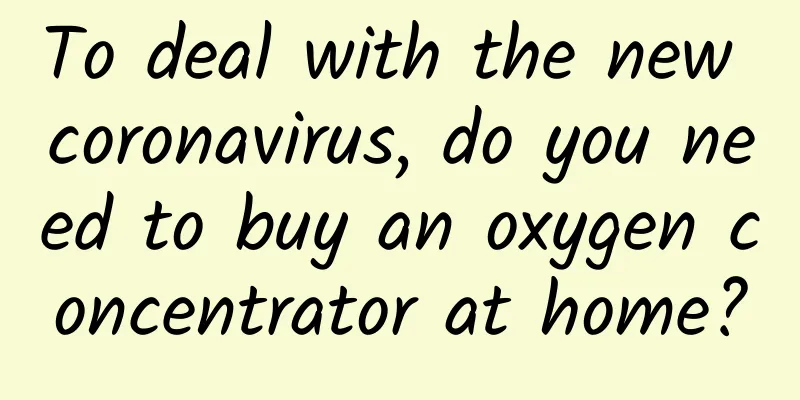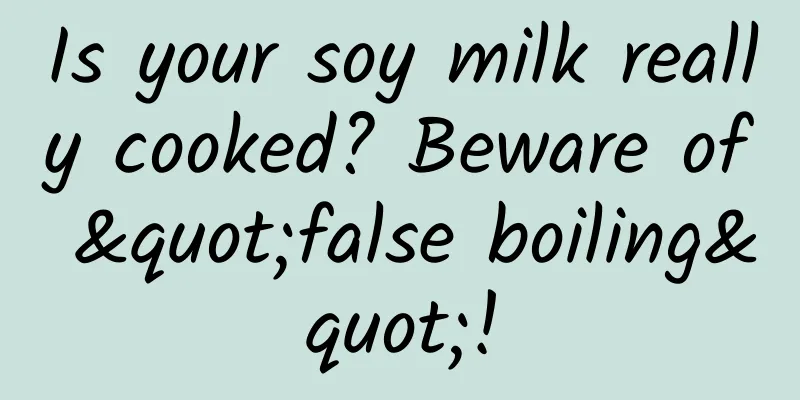To deal with the new coronavirus, do you need to buy an oxygen concentrator at home?

|
On November 11, the National Health Commission issued 20 measures to optimize the prevention and control of the new crown pneumonia epidemic. Popular Science China received many messages and questions from readers, wanting to know how ordinary people can scientifically prevent and prepare. Today, let’s answer a question that everyone is concerned about: Do you need to buy an oxygen concentrator for your home, just in case? Everyone knows the importance of oxygen, which is essential for human life activities. In movies and TV shows, the first thing a critically ill patient does when they arrive at the hospital is to breathe oxygen. Since oxygen is so important, many people take it for granted that healthy people can also breathe some oxygen, prepare an oxygen concentrator at home, breathe some oxygen every day, treat diseases if they have them, and prevent diseases if they don't. In particular, lung infections may cause a decrease in blood oxygen content, and having an oxygen concentrator can replenish oxygen in time. So, is this view correct? Let me first state the conclusion - it is wrong! Not everyone needs to prepare an oxygen concentrator at home to breathe oxygen. So, in what situations do people need oxygen? Who are suitable for home oxygen concentrators? Can COVID-19 patients receive oxygen therapy on their own? The following will answer these questions one by one. Key points: Oxygen is necessary to maintain the normal functioning of cells. Chronic diseases such as the respiratory system, cardiovascular system and tumors can cause breathing difficulties, and lack of oxygen can cause damage to the body's organs. Common home oxygen concentrators provide patients with high concentrations of oxygen by filtering out nitrogen from the air. Oxygen therapy should be performed under the guidance of a doctor. Too high a concentration or too long a time can lead to oxygen poisoning, so do not make your own judgment. The need for oxygen inhalation for patients infected with the new coronavirus also depends on their condition. Asymptomatic and mild cases do not need oxygen, and ordinary cases can use oxygen on demand; severe and critical cases require oxygen. Oxygen inhalation for patients infected with the new coronavirus is also an auxiliary treatment and needs to be used on the basis of combined treatment. If patients infected with the new coronavirus experience obvious chest tightness, shortness of breath, or even difficulty breathing, and the blood oxygen saturation measured by a fingertip oximeter is lower than 93%, it is recommended to go to the hospital for treatment in time and call 120 if necessary. 01 The principle of oxygen concentrator Some people confuse ventilators and oxygen concentrators. The difference is that a ventilator can be used to assist breathing, but it does not produce oxygen and cannot provide oxygen . There are many working principles of oxygen concentrators. Common household oxygen concentrators are like filters, filtering out nitrogen in the air and extracting pure oxygen for patients to use. Oxygen can also be considered a drug, which can be used for emergency treatment of critically ill patients and as an auxiliary treatment for diseases. Supplementing pure oxygen can increase the oxygen content in the body and ensure that cells get sufficient oxygen supply to maintain normal activity functions. However, under normal circumstances, the oxygen in the air can already meet the needs of a healthy human body, and there is no need to use an oxygen concentrator to breathe oxygen. Oxygen is only needed when the oxygen entering the patient's body is reduced, or when the respiratory and circulatory systems are diseased, causing problems with the oxygen-containing air entering the body, oxygen cannot smoothly enter the body's cells, and symptoms of hypoxemia appear. Moreover, if the cause of the disease is not properly treated, oxygen inhalation alone is of little significance. 02 Oxygen therapy required So, which groups of people need oxygen? Specifically, there are four categories: 1. Extremely severe COPD patients need long-term home oxygen therapy during the stable period to improve the patient's survival rate and slow down the rate of lung function damage; 2. Patients with cardiovascular diseases who have developed hypoxemia, such as heart failure, pulmonary hypertension, neuromuscular or chest wall diseases; 3. Patients with other diseases who have hypoxemia , such as advanced cancer patients; 4. When healthy people enter plateau areas, due to the thin oxygen in the environment and the low oxygen content entering the body, they are prone to high-altitude pulmonary edema, acute mountain sickness, chronic mountain sickness, plateau coma, plateau hypoxia , etc., and need oxygen therapy as soon as possible. Copyright image, no permission to reprint It should be noted that even if the above groups of people need oxygen, they should do so under the guidance of medical staff or professionals. The goal of oxygen inhalation is: for patients with chronic diseases, such as COPD, to keep the peripheral blood oxygen saturation (SpO2) no less than 88%; for patients with acute diseases, such as severe pneumonia and heart failure, to keep the SpO2 no less than 95%. Some people think that the higher the concentration of oxygen inhalation, the better, and the longer the time, the better, but this is not the case. Inhaling oxygen at too high a concentration or for too long may lead to oxygen poisoning. 03 Scientific and standardized oxygen therapy 5 principles to follow 1. Oxygen therapy mainly monitors SPO₂ to observe whether there is hypoxia, and the oxygen flow rate should be kept below 3L/min to avoid oxygen poisoning. If the patient develops cyanosis and worsens shortness of breath after activity, and SPO₂ decreases, high-concentration oxygen can be given for a short period of time, and the oxygen concentration can be reduced after the symptoms are relieved; 2. High-concentration oxygen inhalation (>60%) cannot be sustained for more than 24 hours ; 3. Pay attention to the heating and humidification of oxygen; 4. Pay attention to regular disinfection of oxygen pipes to avoid cross infection; 5. Do not smoke or burn items to prevent fire or explosion . 04 Do COVID-19 patients need oxygen therapy? Regarding home oxygen concentrators, the US FDA has issued a warning: 1. You should not use an oxygen concentrator at home unless directed by a doctor. 2. Giving yourself oxygen without talking to your doctor first may do more harm than good. 3. Deciding to use an oxygen concentrator without a prescription may lead to serious health problems, such as oxygen toxicity due to inhaling too much oxygen. 4. The use of home oxygen concentrators may also lead to delayed treatment of serious diseases such as COVID-19. In March this year, my country's National Health Commission issued the "New Coronavirus Pneumonia Diagnosis and Treatment Plan (Trial Ninth Edition)". Let's take a look at what it says about whether patients with new coronary pneumonia should use oxygen concentrators for oxygen therapy: 1. There is no mention of treatment for asymptomatic and mild cases, let alone oxygen inhalation; 2. Ordinary cases should be treated in designated hospitals. Treatment includes general treatment, antiviral treatment, immunotherapy, anticoagulant therapy, prone position treatment, psychological intervention, etc. In general treatment, standardized and effective oxygen therapy measures are given according to the condition, but not everyone needs oxygen inhalation . 3. Severe and critical cases should be admitted to the ICU for treatment as soon as possible. Patients with high-risk factors and a tendency to severe illness should also be admitted to the ICU for treatment. On the basis of the above treatment, complications should be actively prevented and treated, underlying diseases should be treated, secondary infections should be prevented, and organ function support should be provided in a timely manner. For these patients, oxygen therapy should be given immediately , and in severe cases, high-flow nasal oxygen therapy or non-invasive ventilation, or even invasive mechanical ventilation, should be given. However, these need to be used under the strict observation of doctors, and oxygen therapy is only an auxiliary treatment method, and oxygen inhalation alone is not enough. As for the question of whether a home oxygen concentrator is necessary, it is obvious that it does not have the ability to provide oxygen therapy for critically ill patients, so it is not necessary. Copyright image, no permission to reprint In addition, in the item of monitoring vital signs of patients with new coronavirus pneumonia, the "Diagnosis and Treatment Plan for New Coronavirus Pneumonia (Trial Ninth Edition)" emphasizes "especially the oxygen saturation at rest and after activity." How to measure the oxygen saturation is also a concern for everyone. You can buy a finger-clip oximeter to measure the blood oxygen situation. Now many sports bracelets or watches also have the blood oxygen SPO₂ measurement function , but it should be noted that the measurement results of bracelets and watches will not be very accurate. If you want to monitor the blood oxygen situation, you still have to look at the finger-clip oximeter. This small instrument is recommended for everyone to prepare. The average market price is about 100 yuan, and the operation is very simple. Finger clip oximeter. Copyright image, no permission to reprint The purpose of preparing a blood oximeter is to observe whether we have hypoxia and determine whether we need medical treatment based on the observation results. If there is obvious chest tightness, wheezing, or even difficulty breathing, and the finger clip blood oximeter measures blood oxygen saturation below 93%, it is recommended to go to the hospital in time and call 120 if necessary . 05 Facing the coronavirus How can we achieve real protection? Facing the novel coronavirus, there is no need to panic. The methods of protection are actually very simple and everyone knows them. The difficulty lies in persisting in doing them. We need to do the following: 1. Novel coronavirus vaccination ; 2. Maintain good personal and environmental hygiene, balanced nutrition, moderate exercise, adequate rest, and avoid excessive fatigue; 3. Improve health literacy and develop hygienic habits and lifestyles such as keeping a distance of one meter, washing hands frequently, wearing masks, and using public chopsticks. The elderly at home are the key protected objects. If they have the aforementioned underlying diseases such as chronic obstructive pulmonary disease and heart disease, and usually need oxygen treatment, you can prepare an oxygen concentrator. All of us can prepare a finger-clip blood oximeter, which can be used to monitor blood oxygen saturation in case of COVID-19 infection. If it is lower than 93%, seek medical attention in time. Do not delay treatment by relying on having an oxygen concentrator at home. References: [1] The National Health Commission and the State Administration of Traditional Chinese Medicine jointly issued the “Diagnosis and Treatment Plan for Novel Coronavirus Pneumonia (Trial Version 9)” [2].FDA Pulse Oximeters and Oxygen Concentrators: What to Know About At-Home Oxygen Therapy https://www.fda.gov/consumers/consumer-updates/pulse-oximeters-and-oxygen-concentrators-what-know-about-home-oxygen-therapy [3].Continuous or nocturnal oxygen therapy in hypoxemic chronic obstructive lung disease: a clinical trial. Nocturnal Oxygen Therapy Trial Group. Ann Intern Med 1980; 93:391. [4].Long term domiciliary oxygen therapy in chronic hypoxic cor pulmonale complicating chronic bronchitis and emphysema. Report of the Medical Research Council Working Party. Lancet 1981; 1:681. [5].Stoller JK, Panos RJ, Krachman S, et al. Oxygen therapy for patients with COPD: current evidence and the long-term oxygen treatment trial. Chest 2010; 138:179. [6].Jacobs SS, Lederer DJ, Garvey CM, et al. Optimizing Home Oxygen Therapy. An Official American Thoracic Society Workshop Report. Ann Am Thorac Soc 2018; 15:1369. [7].Jacobs SS, Krishnan JA, Lederer DJ, et al. Home Oxygen Therapy for Adults with Chronic Lung Disease. An Official American Thoracic Society Clinical Practice Guideline. Am J Respir Crit Care Med 2020; 202:e121. Author | Sun Siqing, Chief Physician, Department of Respiratory and Critical Care Medicine, Nanjing Second Hospital Review | Jie Zhijun Chief Physician of Respiratory Department, Shanghai Fifth People's Hospital, Fudan University The cover image and the images in this article are from the copyright library Reproduction of image content is not authorized |
<<: It's settled! This thing that caused the Internet to crash will be cancelled in 2035!
>>: "Wukong" these seven years
Recommend
Introduction to the Tik Tok information flow brand advertising matrix!
Douyin’s brand advertising product matrix: Douyin...
How much does it cost to customize the Deyang takeaway mini program? Deyang takeaway mini program customized price inquiry
There is no doubt that the topic of mini programs...
What is the best time to eat breakfast? No later than this time, many people fail to reach it...
When is breakfast considered breakfast? This ques...
Douyin monetization promotion, 7 ways to make money on Douyin!
2018 may be the year when everyone tried out TikT...
Wuhan Tongka real-name authentication! How to download? How to use? Detailed guide attached!
Now Wuhan is gradually restoring its normal life....
What are the minefields in Xiaohongshu’s promotion and operation? Getting Started Manual!
Xiaohongshu, which started out as a UGC community...
App promotion is at a bottleneck? 7 ways to solve your problems!
We all know the importance of App marketing . If ...
Does breathing through the mouth really ruin your appearance?
We need to breathe every moment, but have you eve...
Zhang Chaoyang: TV series are still the "staple food" of Sohu Video
January 30 (Reporter Zhang Zhichang) After the fu...
Microsoft plans to launch a new version of Win10: prohibit the installation of external EXE and only allow access to its own store
Google has two operating systems, Android, which ...
Is Apple blocking third-party batteries out of genuine consideration for users, or is it overbearing marketing?
Apple phones are probably the hottest stars in th...
How to remove the crayfish thread? Can I eat shrimp without removing the shrimp thread? Introducing four tips for cleaning shrimp threads!
Every May, crayfish start to be available on the ...
How to write the copy for New Year gift boxes? Look at what Philips wrote.
Holidays are definitely the golden period for mar...
Bloomberg: The birth of WeChat benefited from the competitive culture within Tencent
Tencent's new headquarters building in Shenzh...
How much will the pension for rural people aged 60 and above be adjusted in 2020? How much money can I receive every month?
Rural elderly people have always been the focus o...









